Julie and Don are Workplace Health and Safety Queensland Safety Advocates.
At the age of 25, Julie and Don Sager's son Adam died from mesothelioma (an asbestos related disease).
Now they visit Queensland businesses as part of the safety advocate campaign, to try and educate people about the risk of exposure to asbestos.
"Before you disturb any building material—especially in homes built before 1990—check whether it is likely to contain asbestos. We couldn’t save Adam’s life, but we hope you can save your child’s life."
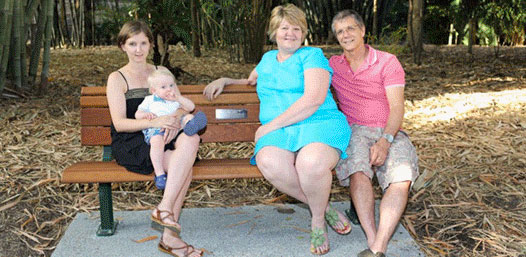
Losing breath - The Adam Sager story
Julie and Don Sager's son, Adam was unknowingly exposed to asbestos dust when he was 18 months old.
At 24, a fit and seemingly healthy Adam was training for the martial arts world championships, when he first developed symptoms of the asbestos disease, mesothelioma. He died just 10 months later at 25 years old.
Losing breath – The Adam Sager story raises awareness of the dangers of disturbing asbestos without adequate precautions, in the hope of sparing other families from going through what Julie and Don have had to endure.
Julie and Don are members of the Consultative committee for work-related fatalities and serious incidents, which was established to ensure there is an ongoing consultative forum for injured workers and families affected by a workplace death, illness or serious incident.
Read more about the committee.
Download a copy of this film (MP4/ZIP, 148MB)
Order your free copies of Julie and Don’s DVD via safe@oir.qld.gov.au.
Your business can apply for Julie and Don Sager or another of Queensland's Safety Advocates to attend your event and share their story to increase awareness and influence behaviour change, free of charge.
Young couple sits on a bench and look at a memorial plaque.
"Oh. What’s it say?"
"Wow, he was only young."
GENERAL TITLE SLIDE: Losing breath: the Adam Sager story
Julie Sager: It was exciting. We, we were only babies, and
Don Sager: Married two years, eighteen month old son, our first home
Julie Sager: And we wanted to do it ourselves! It came in the kit form, but part of was that you had to pay for someone to paint it, or you could paint it yourself.
Don Sager: The only thing we could do to save some money, was to paint it.
Julie Sager: And we had to sand the walls first and 24 years later...
----------------
Julie Sager: Adam was leading a very fast life. He was training to go to the world championships for his martial arts that he was doing.
Don Sager: Yeah, probably the fittest he'd, he'd ever been, and probably just starting to get his life together, going in the right direction
Julie Sager: And he'd rung me and said, 'I'm just not feeling very well; I keep having this flu, and it won't go away'.
Don Sager: He'd been to a doctor, and the doctor said he was just training too hard; to, to slow up. And then he was at work one day, and he leant forward, and he got a pain up under his rib cage.
Julie Sager: So he went to a different doctor who took x-rays.
Don Sager: And he went straight to have the x-ray and found fluid on his lungs. She sent him to emergency and they drained the fluid off his lungs and said go home now, you're ok now.Two days later, he was feeing a bit sicker
Julie Sager: And we took him straight to his doctor, who did an x-ray, and the fluid was back; straight to the Emergency. And I think it was six or seven weeks before he was out. They just did test, after test, after test. They had no idea.
Don Sager: They, they found some, what they said was mesoth-mesothelial cells, but ... that they took one look at him, and said he's too young; that they can't be right.
Julie Sager: This is just impossible, so that's why they just kept testing, and testing.
Don Sager: After being in hospital for five weeks,
Julie Sager: All he wanted to do was go home, and have a shower in his own shower, so he went home.
Don Sager: He went in for a shower and then his phone rang…
Julie Sager: And I picked it up, and it was the specialist that used to be with him in the hospital. And she said, 'I'm just ringing to let you know that I've got the test results back, and I need to tell you that Adam has got malignant mesothelioma, and he's going to be in great pain.' I said 'So... but he's gonna be okay? We just need to learn how to manage this pain.'And she said, 'No, he'll be dead in six months'. And I remember closing his phone, and thinking, I'm pleased I took that phone call, but how do I tell my son he's gonna die?
Don Sager: And so, we broke, broke that to him, and he said, 'Oh well…"
Julie Sager: And he said, "it's all good, they don't know me; it's all good".
Tegan Mallett: No, I had no idea what mesothelioma was. No idea.
Don Sager: That mesothelioma that he got is an asbestos disease. Well, we were told there was nowhere else to get it from.
Dr Keith Adam: The diseases that people potentially get from exposure to asbestos, there are three main diseases. There's asbestosis, which is a, a dusting or a scarring of the lungs… bronchogenic carcinoma ... that's doctor-speak for the ordinary sort of lung cancer ... and also mesothelioma, which is a, a nasty tumour, which arises on the membrane that surrounds the outside of the lungs, and the inside of the ribs.So far as asbestos is concerned, people need to appreciate that the disease results from exposure to very, very f-fine particles. And they're usually produced when people are cutting it with a saw, or an angle grinder, or something like that. When it's just sitting there, it's a potential risk. But that potential is usually not realised unless someone starts damaging it, or breaking it, or cutting it.
Don Sager: We were racking our brains trying to figure out why or where and the only thing that I could remember was being covered in dust, when we were painting our new first home;it was just sitting in the air where we were working
Julie Sager: Adam was with us on certain days.And he'd had this…this little pink dustpan and brush and he used to have a great time, he was always busy.They traced it back, that our home was one of the last ones that was produced using the asbestos sheeting.
Don Sager: Because it' the outerface that you paint, and all that sort of stuff, all the warnings were on the inside.
Julie Sager: I always felt that once we found out where it came from ... that our job as parents, are to protect our children, and we didn't do that.
Helen Colbert: When people find that they're diagnosed with an asbestos-related disease, they feel very confused, very isolated, very frightened, and they really don't know where to turn. And this is where the Society comes into its own.The support and the services that the Society offers, is medical; dietician; nutritional; legal advice; occupational therapy services; phone support; support groups; people may need financial assistance and when things are really tough, they are just marvellous.
Julie Sager: They were sensational ... the Asbestos Society gave us so much information, and so much help.
Helen Colbert: There 'is' no cure for any of the asbestos-related diseases. There's only management. And so, when you're living with that, knowing that there 'is' no cure, you try to make the very best of every day that, that you have, because you really don't know how many that you're going to have.
Tegan Mallett: He would only have minute moments of panic. And, you know, like, Christmas was a really hard time for him. We were all positive, because of him. So he was boosting us all up. And then, all of a sudden, he's a mess out on the stairs! And we were like, 'Hang on a minute, like, Christmas is great! We're ha-having fun at Christmas!' But he knew he was his 'last' Christmas. So he just had this wave of, yeah, sadness. I think he just was kinda taking it all in, as if that would be the last time he would celebrate Christmas with his family.
Julie Sager: He loved his family. And when he 'was' sick, all he wanted, was all of us around. He didn't want to do anything else. let's just us. We're good.
Tegan Mallett: We had lots of conversations, Adam and I, that he couldn't have with Mum and Dad. So I was a little bit more aware of where he was at, in terms of thinking whether he was going to fight it or not.I'd say, you know, 'What do you wish you could do right now? Like, if you could change right now, what do you wish you could do?'And he said ' I don't want to have to, you know, struggle to breathe to get out of bed, and struggle to walk down the hallway, and not be able to get down the stairs; I just want to be able to go [snaps fingers], and be there'. And so we were able to have those conversations towards the end. That was just two nights before he died.
Don Sager: He went to bed the night of the 28th of April. But then he woke us all up, having trouble breathing, at about 3:00 o'clock, on the 29th of April,
Julie Sager: When we got him to the hospital yet again. His eyes were really milky and just… nothing. There was nothing.
Don Sager: And, they tried to put a tube down his throat to get more oxygen into his lungs, but he, he'd obviously decided that it was his time to go
Julie Sager: And I said to the nurse, you know, 'Is this, is this it?' And he said, 'Yep.'
Don Sager: All I could say was, 'Oh, oh mate!' Just keep breathing! You can breathe!'
Julie Sager: and Adam closed his eyes, and I thought, Oh, okay ... so, that's it'.And then he opened his eyes, sorry ... and they were crystal clear. Beautiful blue. And he looked at Don, and he looked at me, and he smiled at both of us, and then he just closed his eyes again. And I just think how much energy and courage that would have taken to do that; to let us know that he was okay, and that he wasn't in any pain. And that it was ok for him to go.
Don Sager: Well we had to tell…had to tell everyone.And now we're 'still' telling everyone, don't let it happen ... please don't...
Tegan Mallett: The guilt just eats away at them. I think they deal with it better now.
Julie Sager: Don was devastated. He used to feel very responsible
Don Sager: I know at the time, I thought I was saving our family some money,
Julie Sager: people have said to me, 'What 'were' you thinking?' 'Well, we didn't know!
Don Sager: I was thinking that I was doing the best by my family at the time.
Julie Sager: I wish we had of been more aware.
Peter McGarry: You know, 30, 40 years ago, asbestos materials were, were commonly used in, in new building materials. There was definitely a lack of awareness … and it was not just the Sagers ... most, most of the community just weren't aware building material in their house contained asbestos.
Helen Colbert: Even today, people do not know what asbestos is, or where asbestos can be located. And that is a very frightening thought.
Dr Keith Adam: Even now, I, unfortunately I see examples where, particularly tradesmen, either through naivety, or perhaps because they're not being careful enough, just go in and start cutting it or drilling it, without giving it the, the thought it needs.I think the problem is that people don't see that there's an immediate hazard, and so just proceed, hoping it'll be okay.People often think of it as an old person's disease… there's a very, often a very long lag time between exposure, and development of disease. So while the disease might be affecting older people, it's the exposure when you're young that may be responsible for that disease. So, young people can't afford to ignore it.
Helen Colbert: Our big concern now is the home renovators, the DIY, because they don't necessarily know where there 'may' actually be Asbestos in their, their home.
Peter McGarry: There was approximately 3,000 different products that contained Asbestos.We should actually make the assumption that Asbestos materials are present in houses or buildings, particularly built before 1990.
Helen Colbert: Awareness saves lives.
Dr Keith Adam: It is, yeah. I mean, awareness is, is the whole solution. If, if we're aware of it, and think of it, we can, we can take appropriate steps to either avoid it, or work with it safely
Julie Sager: So find out what's in the house. Just, take a moment to just gather all the information.There's no excuse for being ignorant now. There's so much information about it.
Peter McGarry: We recommend that anyone contemplating doing some work on a on a building that was built before 1990, that they should have the material tested. It's a relatively simple test…
Julie Sager: Find out what's there, learn how to remove it properly
Helen Colbert: Make sure that the people that you're getting to do the work they are professional qualified licensed people.
Peter McGarry: So the clear message is, you don't know what your future exposure will be. So every time you're working with asbestos containing materials, use the controls that prevent fibres from becoming airborne and breathed in. It's not only your own health that you're putting at risk. You can potentially put at risk the health of people who are, who are nearby.
Tegan Mallett: And that's kinda what you need to remember, when you tamper with it ... is, who am I impacting?
Julie Sager: Just do what you need to do, to keep your family safe. That's our, that's our aim in life, I think, isn't it? Keep the ones you love, safe?
Don Sager: We're still picking up the pieces.There 'is' that thing in the back of your mind saying, 'I-If I 'hadn't' have done it, we would still be having these great Christmases; we would probably be a-, a lot better off; a lot better off'.
Julie Sager: And, people used to say to me, 'It's okay ... everything happens for a reason'. And I haven't quite worked out the reason why I'll never hear the sound of my son's voice again. How do you reconcile the fact that you'll 'never' hear their voice? That you'll never feel them hug you; that he'll never know his nephew.
Tegan Mallett: He reminds me of Adam.
Julie Sager: I definitely see shades of Adam, yeah; cheeky little monkey.
Tegan Mallett: Just him being here makes me feel like Adam's closer.We have a photo on our fridge, and we say goodnight to him every night, and tell him that we miss him, and we wish he was here. So it's kind of bittersweet, 'cause it's nice that he's around, and brings a lot of joy into our family. But it's also incredibly sad that it's not Adam's, and he's not having any kids, and he'll never meet Fletcher. My brother's always been into Asian inspired things, and he loved the Japanese Gardens at Mt Coot-tha Botanical Gardens, and would always go there, even before he was sick.
Julie Sager: And then, particularly after he was unwell. He used to find a lot of solitude there.
Tegan Mallett: They've allowed us to put a bench seat out the front of the Japanese area, under a big clump of bamboo. And it's a beautiful spot.I love sitting on benches and knowing that a guy's made it and dedicated it to his wife. I think that's nice. And I hope that people feel the same way, when they get to sit with Adam, yeah.
Julie Sager: I hate lookin' at his name. Just to see those dates in print, are terrible.
Dedicated to Adam
[End of transcript]
RUN TIME: 16 mins 38 sec
“One thing I will say is that after Don and Julie left my staff were amazed as to where asbestos can be found ie in carpet, pipes etc. Everyone just thinks it in walls and ceilings, but it goes much farther. I also want to say as the business owner and a person who deeply cares for my staff and the welfare of others how grateful I am for this presentation.”
- Chris Maggacis, Instaco Pty
“I received several comments about how this would be discussed with their tradespeople.”
“It was obvious that the audience were taking to heart what was being presented. Also the questions asked showed the interest taken of the presentation.”
- Resources Safety and Health Queensland
“There has definitely been more discussion around safety, with a big focus being on talking about asbestos in the workplace, especially as we are about to start decommissioning a site.”
- Kylie Jones, ITW Polymers and Fluids
“Had a very powerful message that generated conversation beyond their presentation. Comments such as ‘When I get home tonight I'm talking to my family about this’.”
“Julie and Don's story was sad and compelling. It prompted our audience to consider their actions during home renovations and be courageous enough to question things. The courage that they showed presenting at both events was inspiring and we are so grateful to them for sharing their very personal story. I know I will think of Adam when we are renovating or visiting the beautiful Japanese gardens. It is a privilege to share a piece of the Sager's life.”
- Seqwater
"The Safety Advocate session with Julie Sager was very informative and provided a different view of safety in the workplace and how members of the public can be impacted by the business’s processes. Great session and highly recommended. The session was only completed a few hours ago however the feedback so far has been positive."
- Ashley Hodgkinson, Fleetwood Building Solutions
"This story should be a mandatory part of the White Card course as a minimum... brave people and a sad loss."
"Fantastic presentation by all... appreciate it."
"Thank you Don, Julie and panel."
"Thank you Don and Julie for your powerful story, it was very touching."
"Thanks for the session WHSQ. Also, thanks to Don and Julie for sharing their story."
- Viewer comments from the Asbestos Awareness Week online safety session
"We really appreciated the presentation, thanks so much. We had some lovely feedback from conference attendees, it was so appreciated. I was quite wrapped up in listening and I'm so sorry I forgot to take any photos!"
- Rohan Valentine, Nutrien Ag Solutions
"Please extend our gratitude to the Sagers for what was an amazingly touching and effective presentation in Toowoomba today."
- Kevin Bailey, HSE Advisor
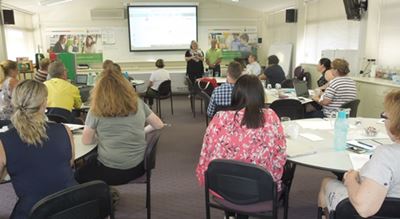
Julie and Don Sager in Toowoomba.
"Julie's presentation was very well received by our management team and subcontractors and we really appreciate Julie taking the time to come to site and present on the Gold Coast in very warm conditions. The type of work SHAPE undertakes (fitout and refurbishment) means there is a potential risk of exposure to asbestos on at least one of our projects every day. Julie and Don Sager's story helps us bring the heartbreaking human factor to the asbestos awareness message which is often the one thing that makes people stop and think, aside from the recent site presentation Julie completed we have used the Adam Sager 'Losing Breath' video a number of times during asbestos awareness presentations and I cannot recommend the Worksafe QLD safety advocate program and resources highly enough!"
- Phillip Smith, Group Executive, Environmental, Health, Safety & Quality, SHAPE
Julie's presentation on 19 October 2018.
"Don and Julie are excellent safety advocates for asbestos with their own personal story which touches the heart of many people and provides inspiration to spread the word how easily it can occur and how devastating the consequences can be with the loss of a human life. There was not one person in the room who did not take the story out of the room to spread this message further. I heard a number of employees saying that they were going home to tell their husbands / partners the dangers of asbestos and renovations. A very powerful message and Don and Julie are both very courageous to talk about their experience and Mackay Hospital and Health Service valued this opportunity and wish them all the best."
- Gail Cameron, WHS Manager, Human Resources and Engagement, Mackay Hospital and Health Service
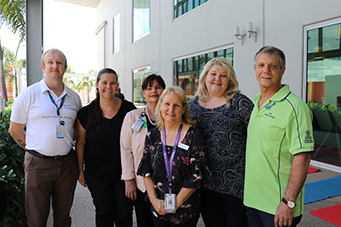
Julie and Don at Mackay Hospital and Health Service.
"A very sincere thank you to the lovely Don and Julie for making today so memorable.
I understand how difficult it must be for Don and Julie to speak out about what happened to Adam and we all appreciate their time and applaud their work in making people aware and making a difference in the lives of others.
The feedback has been so extremely positive, and the conversations happening in the offices this afternoon are already highlighting the profound and positive impact this event has had."
- Emma Wyhoon, GradDipOHS, COHSPrac, Work Health & Safety Advisor, Diocese of Cairns
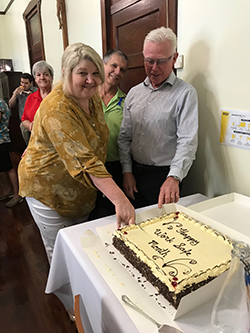
Julie and Don at Cairns Catholic Diocese.
"When a fireman goes into a building to rescue somebody, they are hailed as a hero; when a safety manager puts a procedure in place that could potentially save a hundred people from a catastrophe, nobody notices. Although it is of little consolation, Julie and Don may be saving people from potential asbestos exposure with their powerful story; I don 't think presentations get much more powerful than the Sagers'; I don 't think there was a dry eye in the house.
Many attendees in today's audience have an awareness of asbestos management procedures within their workplace, but many admitted that they don 't closely monitor these procedures to the level they should. The Sagers' reminded us that people sometimes have this blasé attitude, when the damage can be occurring in our workplaces right now."
- David Kemp, President FNQ Safety Group
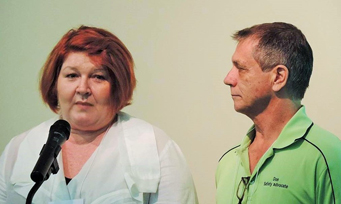
Julie and Don talk to the FNQ Safety Group in Cairns.
"The safety advocates were a huge success. The impact they had on the audience - in particular the young people - was priceless. At the end of the session many people had tears in their eyes and came and hugged Julie and Don, who had truly reached in to the hearts of the audience. We were inundated with enquiries about running these at other workplaces, as they want all their people to experience this powerful and riveting safety message. We will certainly use them again."
- Rob Noble, Regional Operations Manager, WHSQ
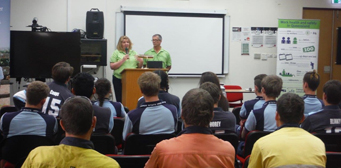
Julie and Don speaking at a Safe Work Month event held at TAFE.
"Having someone like Julie Sager come and speak to your team about her story, and about the dangers of asbestos – it really helps to make people understand what can happen, and puts things into perspective. She opened my eyes, and I 'm pretty sure she made everyone in the room sit up and pay attention."
- Cherie Vettiger, Inspector, Workplace Health & Safety Queensland Manager, Australia Post
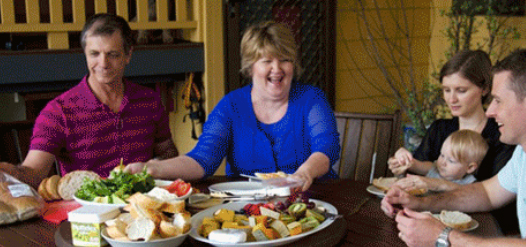
Leave a comment for Julie and Don Sager
A tough story to watch but want complement you, the team and the family.
Les
WHSQ always hit the mark with these videos. I will be sharing this with as many people as possible to try make a difference.
Scott
Thank you to the Sagers.
Mark
To all of Adam's family, I lost my brother to Asbestos exposure, he was 45 years old. It was and is still hard for my parents along with his wife and 3 boys to cope with not having him around. If this video prevents just one person from being exposed to asbestos then this video has done it's job. I work in safety now and can't push enough the risks of asbestos. My thoughts are with you all.
Karen
A very sad story from a wonderful and brave family, Adam was a beautiful soul.
Fiona
Adam's legacy will live on forever, thanks to the commitment and bravery of the Sager Family. Everyone needs to remember 'Family is everything' The Macca's.
Cheryl
Thank you to the Sager family for sharing your story and for raising this subject to the fore. Your sad story may well save another's life. My thoughts are with you all.
Yvonne
Thanks so much to the Sager family for sharing for what must have been a harrowing time in there lives As a person who has been training the construction industry for some 20 yrs in asbestos management you would still never believe the risk takers out there that don't understand the risks they are taking for their own personal health not mention their fellow work mates.
Geoff
Sad but yet beautiful video. Such a moving and informative video for awareness as well. My heart goes to the family.
Karen
Thank you for sharing your story. I found it humbling hearing your story face to face at the launch. Your family is incredibly brave. This is such a sad story. I will ensure we continue to drive the message forward.
Colin
This film shows the importance of spreading awareness of asbestos related diseases. My mother was diagnosed 3 years ago with Asbestosis. She had been treated as having asthma all her life until properly diagnosed. Her father was a builder and when she was young she used to dust of his overalls after work and wash them. That exposure has resulted in her asbestosis. It is a terrible disease and I only hope more awareness continues to prevent as many more cases as possible.
Nicole
Very powerful story. Any person could make this mistake eventually leading to a fatal outcome. Knowledge is power, please watch.
Sharon
Julie & Don what amazing parents you are and he would be so proud of you all. Hopefully people will take notice and listen and act appropriately.
Anne-Marie
This film tells such a sad story, it's a danger we don't even think of in our homes. Thanks to the Sager family for sharing their story, so so sad.
Melanie
This is the saddest film I've seen. It is such a wake-up call. I would never have thought about asbestos in my home, but now I will. My heart goes out to the Sagers.
Leigh
Thank you for sharing your story. You are incredibly brave. This is such a sad story. I will be thinking differently about asbestos from now on.
Matthew
Workplace visits
Your business can apply for Julie and Don Sager or another of Queensland's Safety Advocates to attend your event and share their story to increase awareness and influence behaviour change, free of charge.
Losing breath - The Adam Sager story
- Download a copy of this film (MP4/ZIP, 148MB)
Consultative committee for work-related fatalities and serious incidents
If you have suffered as a result of a work-related fatality or serious injury, you can direct message a request to join a closed support group via our Support for families of workplace fatalities, illness and injuries Facebook page.